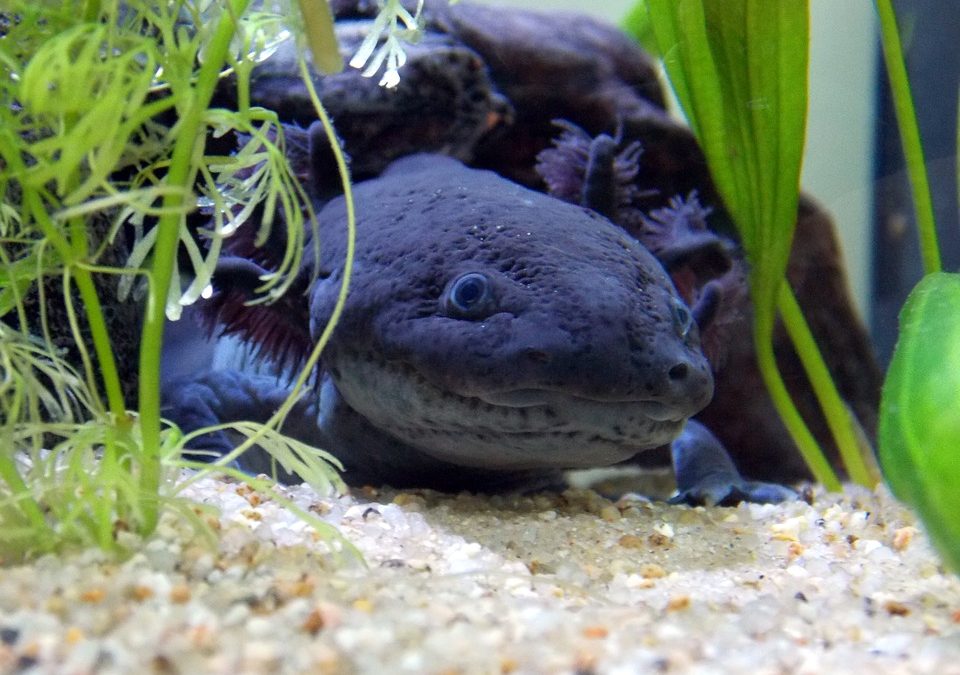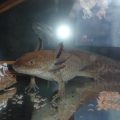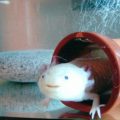So what do Axolotls eat? First thing you need to know is that Axolotls are carnivores which mean that they require a meat – based diet. They have rudimentary teeth that are designed for gripping instead of tearing or biting. This is why they usually swallow their food as a whole, which means that anything they want to eat should fit into their mouths. When an axolotl is hand – fed and become quite used to people, it may occasionally latch onto a finger. You will be able to feel their little teeth quite distinctly but don’t worry because it’s more of a curious experience and not at all painful. This is because the axolotl’s teeth don’t have the strength to pierce a human skin, so don’t be afraid to try it still though exercise some caution. The Axolotl’s teeth come into their own when trying to grip or eat something slippery like an earthworm. The worm may try to get away but it will eventually find it hard to escape the mouth of the Axolotl. If the worm is too big to be swallowed completely, the Axolotl will eventually give it up and let it go. You see, large food is definitely a problem when you don’t have a set of teeth that are designed to bite. This article will give you information on what axolotls eat.
Axolotl are also known as Ambystoma Mexicanum. The word Ambystoma means cup – mouth which is one of the distinctive characteristics of Axolotls. You will find that they do have large and wide mouths ready to swallow any food that can fit it. When an axolotl wants to eat something, it opens its mouth and just like a vacuum water rushes in along with the food. This sort of vacuum action may often result to a sudden lurch where you can find the axolotl up into the water before settling down again.
What axolotls eat either live or dead food. The movement of live food like a worm is a great stimulus for this animal to snap at it. As for newly hatched axolotls, movement of the prey is the only stimulus to which they will respond.
Earthworms are a good food source for matured ones, but just make sure to get them from a source that doesn’t use chemicals such as an organic garden otherwise the chemicals may affect your Axolotl one way or another.
We highly recommend that you raise these earthworms or any feeders yourself if you have the time and space so you can also have the option to gut – feed them and pass on the nutrients to your pet. Don’t try to feed your Axolotl with live feeder fish because these are known to carry diseases and they usually are infected with parasites so never offer that to your pet Axolotl otherwise it could be fatal for him/ her.
You can also use soft sinking salmon feed pellets because most owners find that they are well – received by axolotls. These pellets are soft, moist, and retain their shape for a long time. If you feed mealworms to your axolotl, be careful because the chitin which is the protein that makes up the hard exoskeleton in insects could be indigestible to the axolotls. The Indiana University Axolotl Colony, when it still existed, fed its axolotls with high protein and vitamin fortified pellets designed for salmon. The pellets are 45% protein and 20% fat but then they eventually found that the axolotls didn’t like the hard variant of pellet which is why you need to ensure your pellets are soft.
Feeders for Axolotls
Water – based live foods can be quite risky since as mentioned earlier, they can be a source of disease. However, if taken from fish-free waters, they tend to be a lot safer. A good food called Tubifex is not nutritionally balanced for axolotls, and sometimes it can carry diseases that may come from dangerous bacteria and parasites. There are also reports that Tubifex attack salamander eggs. Tubifex are often mistakenly called bloodworms in America but it shouldn’t be confused with the true bloodworms. If you want to feed Tubifex to your Axolotl, we suggest you choose the freeze – dried or frozen ones as it is much safer than live but do note that freeze – dried may not be nutritious at all.
Bloodworms are not worms, they are midge larvae. These creatures get their name from their bright red coloration. They usually live in the sediments of ponds, where they feed on detritus. Bloodworms make a very nutritious and well – balanced food, but you must get them from fish – free waters. Frozen bloodworm cubes are indispensable especially when raising young axolotls, which is why it’s highly recommended.
Blackworms are cousins of earthworms but they are only much thinner and smaller than earthworms and they also have a dark brown shade. Blackworms have a similarly high nutritional value to that of earthworms which makes them a very good choice. They can also be cultured in captivity, but you can usually buy them from pet stores and they are also conveniently available in aquarium shops. Do not feed blackworms that were caught in the wild because they can pose the same disease problems as Tubifex. Make sure to get them from fish – free waters to avoid passing on any disease to your Axolotl.
Whiteworms which are closely related to Grindal worms are quite common feeders for juvenile species and it is because they are a good food source though they tend to be quite fatty and oily. Bloodworms and blackworms can be fed as a staple as long as there is a small variety occasionally to offset any sort of imbalance. On the other hand whiteworms and grindal worms should be used as a treat or a temporary food and not the main diet.
One thing to bear in mind when feeding axolotls is that they need high quality foods with low oil and fat contents. Your pet may develop liver problems if constantly fed on foods with high oil content. It’s important to note what you’re feeding is balanced in terms of protein and vitamin content. It’s no use feeding a high protein food if the Axolotl is not getting enough of one vitamin or another. We hope that this article gave you an idea of what axolotls eat and how you can feed them.






 Author and long-time animal lover. Sharing knowledge on pet care through experience and the written word.
Author and long-time animal lover. Sharing knowledge on pet care through experience and the written word.